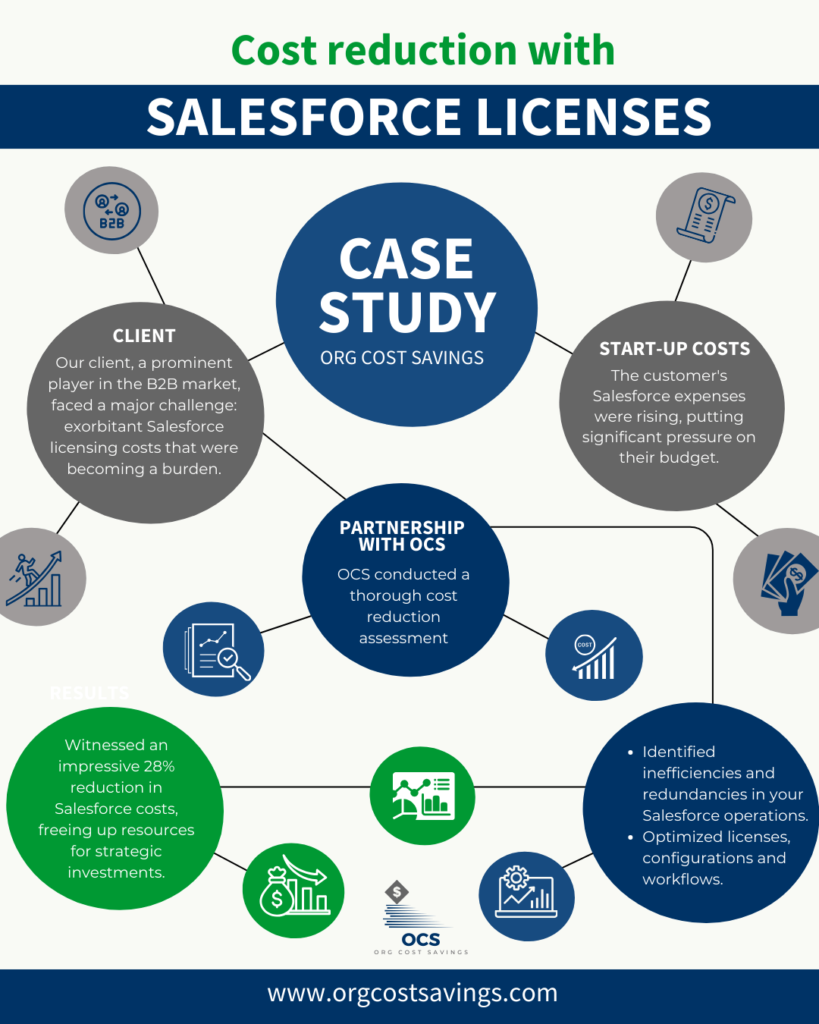Looking to optimize your budget for Salesforce licensing costs? Look no further.
In this comprehensive guide, we break down everything you need to know about Salesforce licensing costs and provide expert tips on how to budget effectively.
Salesforce is a powerful CRM platform used by businesses of all sizes to streamline their sales and marketing processes. However, navigating the various licensing options can be overwhelming, especially for those new to the platform.
Understanding the different license types, features, and pricing models is essential to avoid overspending and maximize the value of your Salesforce investment.
Whether you are considering Salesforce for the first time or looking to optimize your existing licenses, this guide will walk you through the various factors to consider, including user types, license editions, add-on features, and pricing models.
We will also provide practical tips on how to align licensing costs with your business needs, avoid unnecessary expenditures, and ensure optimal utilization of Salesforce functionalities.
Get ready to unlock the full potential of Salesforce while optimizing your budget. Let’s dive in and discover how you can make the most of your Salesforce licensing costs.
Different types of Salesforce licenses
Salesforce offers a range of license types to cater to different user roles and requirements. Understanding the different license types is crucial as it determines the functionality and access level each user will have within the platform.
1. Salesforce Essentials:
This entry-level license is designed for small businesses or startups with basic CRM needs. It provides essential features such as contact and opportunity management, email integration, and customizable dashboards. Salesforce Essentials is a cost-effective option for businesses with a limited number of users.
2. Salesforce Professional:
The Professional license is suitable for sales and service teams that require advanced features such as lead management, workflow automation, and forecasting. It offers increased customization options, integration capabilities, and access to the Salesforce AppExchange marketplace.
3. Salesforce Enterprise:
With enhanced security features, advanced automation capabilities, and expanded data storage, the Enterprise license is suitable for organizations with complex sales and marketing processes. It offers additional functionalities such as territory management, advanced reporting, and access to the Salesforce Einstein AI platform.
4. Salesforce Unlimited:
The Unlimited license provides the most comprehensive set of features and functionalities, making it ideal for large enterprises with complex CRM requirements. It offers unlimited customization options, flexible API access, and advanced analytics capabilities.
Choosing the right license type depends on your business needs, user roles, and budget constraints. Assessing the specific requirements of your organization will help you select the most cost-effective option without compromising functionality.
Factors affecting Salesforce licensing costs
When budgeting for Salesforce licenses, it’s important to consider the factors that impact the overall cost. By understanding these factors, you can make informed decisions and allocate your resources effectively.
- 1. User Types: Salesforce offers different user types, including full users, read-only users, and platform users. Full users have complete access to all Salesforce functionalities, while read-only users can only view data without making any changes. Platform users have limited access and are typically used for integration purposes. Understanding your users’ needs will help you determine the appropriate user type and minimize unnecessary licensing costs.
- 2. License Editions: Salesforce offers different editions of its CRM platform, each with varying levels of functionality and features. The cost of licensing depends on the edition you choose, ranging from the basic Essentials edition to the more advanced and feature-rich Unlimited edition. Assess your organization’s requirements and select the edition that aligns with your needs and budget.
- 3. Add-On Features: Salesforce provides a wide range of add-on features and capabilities that can enhance your CRM experience. These add-ons, such as Sales Cloud, Service Cloud, Marketing Cloud, and Commerce Cloud, come at an additional cost.
Evaluate your business requirements and determine which add-ons are essential for your organization. Avoid unnecessary expenditures by only investing in features that will directly impact your business processes.
Understanding Salesforce pricing models

To effectively budget for Salesforce licenses, it’s crucial to understand the pricing models offered by Salesforce. The pricing models determine how the licensing costs are calculated and can significantly impact your overall expenses. Here are the key pricing models to consider:
- 1. Per User, Per Month: This model charges a fixed monthly fee for each user, based on the license type and edition. It is the most common pricing model for Salesforce licenses and allows for easy scalability as your business grows.
- 2. Per User, Per Year: Salesforce also offers annual licensing options, where you pay for each user on a yearly basis. This model often comes with cost savings compared to the monthly pricing option, making it ideal for long-term commitments.
- 3. Volume Pricing: For large organizations with a significant number of users, Salesforce offers volume pricing discounts. These discounts are based on the number of licenses purchased and can result in substantial cost savings.
By understanding the pricing models and their implications, you can choose the most cost-effective option for your organization and avoid any unexpected expenses.
Tips for budgeting for Salesforce licenses
Effective budgeting is essential to ensure that your Salesforce licensing costs align with your business needs and goals. Here are some practical tips to help you optimize your budget:
- 1. Perform a Needs Assessment: Conduct a thorough analysis of your organization’s CRM requirements and identify the specific functionalities and features you need. This will help you avoid unnecessary expenditures on licenses or add-ons that are not essential for your business processes.
- 2. Consider User Adoption: User adoption plays a crucial role in maximizing the value of your Salesforce investment. Ensure that your employees receive proper training and support to encourage active usage of the platform. By promoting user adoption, you can make the most of your licenses and avoid wasted resources.
- 3. Regularly Review License Usage: Periodically review the usage of your Salesforce licenses to identify any redundant or underutilized licenses. By removing unused licenses, you can optimize your budget and reallocate resources to areas that need them the most.
- 4. Explore Non-Profit Discounts: If you are a non-profit organization, Salesforce offers special pricing and discounts through their Salesforce.org program. Take advantage of these discounts to reduce your licensing costs and allocate more resources to your mission.
By following these budgeting tips, you can ensure that your Salesforce licensing costs are optimized and aligned with your business objectives.
Optimizing Salesforce licenses for cost efficiency

In addition to budgeting effectively, there are several strategies you can employ to optimize your Salesforce licenses for maximum cost efficiency. By implementing these strategies, you can make the most of your licenses and minimize unnecessary expenditures.
- 1. Customize User Profiles: Tailor user profiles to match the specific needs of each user role. By customizing profiles, you can ensure that each user has access to the necessary functionalities without paying for additional licenses or features.
- 2. Leverage Salesforce Lightning: Salesforce Lightning is a modern and intuitive user interface that enhances productivity and user experience. By adopting Salesforce Lightning, you can improve user efficiency, reduce training costs, and potentially reduce the number of licenses needed.
- 3. Maximize Automation: Salesforce offers powerful automation capabilities, such as workflow rules, process builder, and approval processes. By leveraging these automation tools, you can streamline your business processes, reduce manual work, and potentially optimize the number of licenses required.
- 4. Evaluate AppExchange Solutions: The Salesforce AppExchange marketplace offers a wide range of third-party applications and integrations. Explore these solutions to enhance your CRM experience and potentially reduce the need for additional licenses or custom development.
By implementing these optimization strategies, you can minimize unnecessary licensing costs and ensure that your Salesforce investment delivers maximum value.
Evaluating Salesforce license usage and needs
Regularly assessing your Salesforce license usage and needs is essential to avoid overspending and optimize your licensing costs. By performing periodic assessments, you can identify areas for improvement and make informed decisions regarding your licenses.
OCS is here to help you with this task. We have a team of consultants who are highly qualified in reducing costs with Salesforce licenses.
The results of our clients prove our qualifications.
See below the case study that, through our consultancy on cost reduction with licensing Salesforce, our client reduced its expenses by 28%.

By performing regular assessments, you can ensure your Salesforce licenses are aligned with your evolving business needs and optimize your licensing costs accordingly.
Contact us as we are ready to help you reduce your costs and maximize your ROI.
Negotiating Salesforce licensing contracts
When it comes to negotiating Salesforce licensing contracts, there are several strategies you can employ to secure the best possible terms and pricing. By following these negotiation tips, you can potentially reduce your licensing costs and maximize your ROI:
- 1. Leverage Competition: Salesforce faces competition from other CRM providers. Use this to your advantage by exploring alternative options and negotiating competitive pricing. Highlight your willingness to consider other solutions to incentivize Salesforce to offer more favorable terms.
- 2. Bundle Licenses and Add-Ons: Consider bundling multiple licenses or add-ons together to negotiate a better overall pricing package. By bundling, you can potentially secure volume discounts and reduce your licensing costs.
- 3. Renewal Negotiations: When renewing your Salesforce licenses, don’t be afraid to negotiate. Gather data on your usage, user adoption, and any issues you may have faced during your contract period. Use this information to negotiate more favorable terms and pricing.
- 4. Seek Professional Assistance: If negotiation is not your strong suit, consider engaging a Salesforce licensing consultant or legal professional to assist you. Their expertise can help you navigate the negotiation process and secure the best possible terms.
By employing these negotiation strategies, you can potentially reduce your Salesforce licensing costs and achieve more favorable contract terms.
Conclusion: Maximizing ROI with Salesforce licensing
Optimizing your budget for Salesforce licensing costs is crucial to maximize the return on your investment. By understanding the different license types, pricing models, and factors that impact licensing costs, you can make informed decisions and allocate your resources effectively.
Remember to assess your organization’s specific needs, regularly review license usage, and implement optimization strategies to minimize unnecessary expenditures. Negotiate your licensing contracts to secure the best possible terms, and leverage Salesforce’s license management tools and resources to manage your licenses efficiently.
By following these guidelines, you can unlock the full potential of Salesforce while optimizing your budget, ensuring that your investment delivers maximum ROI.
OCS Salesforce Consulting
OCS – Org Cost Savings stands out as the trusted choice to guide your business on this transformation journey. We offer comprehensive Salesforce consulting services, from in-depth analytics to customized strategies to increase savings and efficiency across your organization.
By relying on OCS expertise, your organization can save up to 30% on Salesforce costs, driving additional resources into strategic areas that catalyze growth and innovation.
Don’t miss the opportunity to optimize your Salesforce investment and get the most value from the industry-leading CRM platform. Contact us for a free trial and find out how OCS can be your partner for efficient Salesforce management.
Congratulations! You now have a comprehensive guide to budgeting and optimizing Salesforce licensing costs. Use this resource to make informed decisions, maximize your Salesforce investment, and achieve cost efficiency.







Your content brightens my day.
Thank you for your comment.
Muito detalhado, muito obrigado!
Thank you for your feedback.